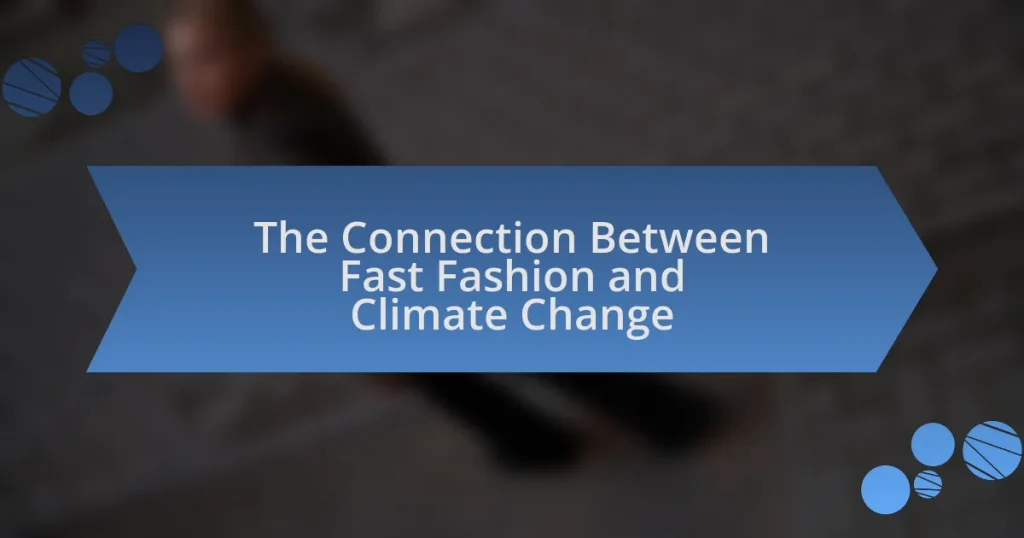The article examines the significant connection between fast fashion and climate change, highlighting how the industry contributes to approximately 10% of global carbon emissions through energy-intensive production and transportation processes. It discusses the environmental impacts of fast fashion, including resource depletion, waste generation, and pollution, with an estimated 92 million tons of textile waste produced annually. The article also addresses the role of consumer behavior and corporate practices in exacerbating these issues, while emphasizing the need for sustainable alternatives and responsible consumption to mitigate the detrimental effects of fast fashion on the environment. Additionally, it explores the social implications of fast fashion, particularly in developing countries, and outlines potential actions and policies to promote sustainability within the fashion industry.

What is the connection between fast fashion and climate change?
Fast fashion significantly contributes to climate change through high levels of carbon emissions, resource depletion, and waste generation. The fast fashion industry is responsible for approximately 10% of global carbon emissions, primarily due to the energy-intensive processes involved in manufacturing and transporting clothing. Additionally, the production of synthetic fibers, commonly used in fast fashion, releases greenhouse gases and consumes vast amounts of water, exacerbating environmental degradation. Furthermore, the rapid turnover of clothing leads to massive amounts of textile waste, with an estimated 92 million tons discarded annually, which contributes to landfill emissions and further impacts climate change.
How does fast fashion contribute to climate change?
Fast fashion contributes to climate change primarily through high levels of greenhouse gas emissions generated during production, transportation, and disposal of clothing. The fashion industry is responsible for approximately 10% of global carbon emissions, largely due to the energy-intensive processes involved in manufacturing synthetic fibers and the rapid turnover of clothing that leads to increased waste. Additionally, the production of textiles often involves the use of harmful chemicals and water-intensive practices, which further exacerbate environmental degradation. According to the United Nations Environment Programme, if the fashion industry continues on its current trajectory, its emissions could rise by more than 50% by 2030, significantly impacting global warming.
What are the environmental impacts of fast fashion production?
Fast fashion production significantly contributes to environmental degradation through high levels of waste, water pollution, and carbon emissions. The industry generates approximately 92 million tons of textile waste annually, with a large portion ending up in landfills. Additionally, the production process consumes vast amounts of water, with estimates suggesting that it takes about 2,700 liters of water to produce a single cotton t-shirt, leading to water scarcity in many regions. Furthermore, fast fashion is responsible for around 10% of global carbon emissions, primarily due to energy-intensive manufacturing processes and transportation. These factors collectively highlight the detrimental environmental impacts associated with fast fashion production.
How does consumer behavior in fast fashion exacerbate climate change?
Consumer behavior in fast fashion exacerbates climate change primarily through the high demand for cheap, disposable clothing, which leads to increased production and waste. This industry is responsible for approximately 10% of global carbon emissions, as the rapid turnover of fashion items encourages overproduction and contributes to significant resource depletion. Additionally, the average consumer purchases 60% more clothing than in 2000, resulting in a staggering 92 million tons of textile waste generated annually, much of which ends up in landfills. The fast fashion model promotes a cycle of consumption that prioritizes low-cost, low-quality garments, further intensifying the environmental impact through pollution and greenhouse gas emissions associated with manufacturing, transportation, and disposal processes.
Why is fast fashion considered unsustainable?
Fast fashion is considered unsustainable due to its significant environmental impact, including high levels of waste, pollution, and resource consumption. The fast fashion industry produces approximately 92 million tons of textile waste annually, contributing to landfills and environmental degradation. Additionally, the production processes often involve toxic chemicals that pollute water sources, with the fashion industry being responsible for about 20% of global wastewater. Furthermore, fast fashion relies on rapid production cycles that deplete natural resources, such as water and energy, exacerbating climate change. This unsustainable model prioritizes short-term profits over long-term ecological health, making it detrimental to the environment.
What resources are overused in fast fashion manufacturing?
Water, cotton, and synthetic fibers are overused in fast fashion manufacturing. The production of cotton requires approximately 7,000 liters of water to produce just one kilogram of the fiber, contributing significantly to water scarcity in many regions. Additionally, synthetic fibers, such as polyester, are derived from petroleum, leading to high fossil fuel consumption and greenhouse gas emissions during their production. The fast fashion industry is responsible for 10% of global carbon emissions, highlighting the environmental impact of these overused resources.
How does fast fashion affect waste generation and pollution?
Fast fashion significantly increases waste generation and pollution due to its rapid production cycles and low-quality materials. The industry produces approximately 92 million tons of textile waste annually, with a large portion ending up in landfills. Additionally, the production processes involve toxic chemicals that contaminate water sources, contributing to pollution. For instance, the World Bank estimates that the fashion industry is responsible for 20% of global wastewater. This combination of high waste output and environmental contamination illustrates the detrimental impact of fast fashion on both waste generation and pollution levels.
What role do corporations play in the fast fashion and climate change connection?
Corporations are central to the fast fashion and climate change connection as they drive the production and consumption of low-cost, rapidly produced clothing that significantly contributes to environmental degradation. Fast fashion brands, such as Zara and H&M, produce millions of garments each year, leading to increased textile waste and carbon emissions; for instance, the fashion industry is responsible for approximately 10% of global carbon emissions. Additionally, these corporations often prioritize profit over sustainability, utilizing unsustainable materials and practices that exacerbate climate change, such as water-intensive cotton farming and toxic dyeing processes. This corporate behavior not only accelerates resource depletion but also undermines efforts to combat climate change, as the industry continues to expand without adequate environmental regulations or accountability.
How do corporate practices influence environmental policies?
Corporate practices significantly influence environmental policies by shaping regulatory frameworks and public perceptions. For instance, the fast fashion industry, characterized by rapid production cycles and low-cost materials, often leads to increased waste and pollution, prompting governments to implement stricter environmental regulations. A study by the Ellen MacArthur Foundation highlights that the fashion sector is responsible for 10% of global carbon emissions, which has led policymakers to consider more stringent measures to mitigate environmental impacts. Additionally, corporations that adopt sustainable practices can drive policy changes by demonstrating the viability of eco-friendly alternatives, thereby encouraging legislation that supports sustainable development.
What are the responsibilities of fast fashion brands towards sustainability?
Fast fashion brands are responsible for implementing sustainable practices to mitigate their environmental impact. These responsibilities include reducing waste through recycling and upcycling initiatives, utilizing eco-friendly materials, and ensuring ethical labor practices throughout their supply chains. For instance, the Ellen MacArthur Foundation reports that the fashion industry is responsible for 10% of global carbon emissions, highlighting the urgent need for brands to adopt sustainable practices. Additionally, brands must commit to transparency in their sourcing and production processes, allowing consumers to make informed choices. By prioritizing sustainability, fast fashion brands can significantly contribute to reducing their carbon footprint and promoting a more sustainable future.
How can consumers mitigate the impact of fast fashion on climate change?
Consumers can mitigate the impact of fast fashion on climate change by adopting sustainable shopping practices. This includes choosing to buy second-hand clothing, which reduces demand for new production and minimizes waste; opting for high-quality, durable garments that last longer, thereby decreasing the frequency of purchases; and supporting brands that prioritize ethical production and environmental sustainability. According to a report by the Ellen MacArthur Foundation, extending the life of clothing by just nine months can reduce carbon, water, and waste footprints by 20-30%. By making conscious choices, consumers can significantly lessen the environmental burden associated with fast fashion.
What alternatives exist to fast fashion that are more sustainable?
Sustainable alternatives to fast fashion include thrift shopping, upcycling, and purchasing from ethical brands. Thrift shopping reduces waste by giving pre-owned clothing a new life, while upcycling transforms old garments into new items, minimizing the need for new resources. Ethical brands prioritize sustainable materials and fair labor practices, contributing to a more responsible fashion industry. According to a 2021 report by the Ellen MacArthur Foundation, shifting to a circular economy in fashion could reduce greenhouse gas emissions by 44% by 2030, highlighting the environmental benefits of these alternatives.

What are the broader implications of fast fashion on the environment?
Fast fashion significantly contributes to environmental degradation through increased waste, pollution, and resource depletion. The industry produces approximately 92 million tons of textile waste annually, with a large portion ending up in landfills, where it can take decades to decompose. Additionally, fast fashion is responsible for around 10% of global carbon emissions, exacerbating climate change. The production processes often involve toxic chemicals that contaminate water sources, harming ecosystems and human health. Furthermore, the demand for cheap materials leads to unsustainable practices, such as deforestation and excessive water usage, with the fashion industry consuming about 79 billion cubic meters of water each year. These factors collectively highlight the urgent need for sustainable practices in the fashion industry to mitigate its environmental impact.
How does fast fashion affect biodiversity and ecosystems?
Fast fashion significantly harms biodiversity and ecosystems by promoting unsustainable production practices that lead to habitat destruction, pollution, and resource depletion. The rapid turnover of clothing collections encourages the use of synthetic materials, which contribute to microplastic pollution in oceans, adversely affecting marine life. Additionally, the agricultural practices for cotton and other fibers often involve harmful pesticides and fertilizers, which can degrade soil health and reduce local biodiversity. According to a report by the United Nations Environment Programme, the fashion industry is responsible for 20% of global wastewater and 10% of carbon emissions, further exacerbating climate change and its impact on ecosystems.
What specific ecosystems are threatened by fast fashion practices?
Fast fashion practices threaten several specific ecosystems, including freshwater ecosystems, marine ecosystems, and forest ecosystems. The production of fast fashion often involves the excessive use of water, leading to the depletion and pollution of freshwater sources, which disrupts aquatic life. For instance, the textile dyeing process releases toxic chemicals into rivers, harming freshwater biodiversity. Additionally, the over-extraction of resources for cotton farming contributes to deforestation, impacting forest ecosystems and the wildlife that depends on them. Furthermore, microplastics from synthetic fibers enter marine ecosystems, causing significant harm to marine life and food chains. These practices collectively contribute to biodiversity loss and ecosystem degradation, highlighting the urgent need for sustainable alternatives in the fashion industry.
How does fast fashion contribute to resource depletion?
Fast fashion contributes to resource depletion by promoting the rapid production and consumption of clothing, which leads to excessive use of natural resources. The industry requires vast amounts of water, with estimates indicating that producing a single cotton shirt can consume up to 2,700 liters of water, enough for one person to drink for two and a half years. Additionally, the fast fashion model relies on synthetic fibers, such as polyester, which are derived from petroleum, further depleting fossil fuel reserves. The constant cycle of producing low-cost garments encourages over-extraction of raw materials, resulting in deforestation, soil degradation, and loss of biodiversity. This unsustainable approach not only strains environmental resources but also exacerbates climate change through increased greenhouse gas emissions associated with production and transportation.
What are the social implications of fast fashion related to climate change?
Fast fashion significantly contributes to climate change, leading to various social implications such as increased inequality and labor exploitation. The fast fashion industry is responsible for approximately 10% of global carbon emissions, exacerbating climate-related issues that disproportionately affect marginalized communities. These communities often face the brunt of climate impacts, including extreme weather events and resource scarcity, which can lead to displacement and loss of livelihoods. Furthermore, the demand for cheap labor in fast fashion results in poor working conditions and low wages, perpetuating cycles of poverty and social injustice. Studies indicate that workers in developing countries, where many fast fashion brands source their products, often endure unsafe environments and lack basic rights, highlighting the intersection of environmental degradation and social inequity.
How does fast fashion impact communities in developing countries?
Fast fashion negatively impacts communities in developing countries by perpetuating low wages and poor working conditions. Workers in these regions often receive minimal compensation, with reports indicating that garment workers in countries like Bangladesh earn as little as $95 per month, which is below the living wage. Additionally, fast fashion contributes to environmental degradation, as factories discharge toxic waste into local water sources, affecting the health of nearby communities. This industry also fosters a cycle of poverty, as the demand for cheap labor leads to exploitative practices, limiting workers’ rights and access to education.
What are the labor conditions associated with fast fashion production?
Labor conditions associated with fast fashion production are often characterized by low wages, long working hours, and unsafe working environments. Workers in countries like Bangladesh and Vietnam frequently earn less than the minimum wage, with reports indicating that garment workers can earn as little as $3 per day. Additionally, these workers often face excessive overtime, sometimes exceeding 60 hours a week, without proper compensation. Safety standards are typically inadequate, leading to hazardous conditions, as evidenced by incidents like the Rana Plaza collapse in 2013, which killed over 1,100 workers. These conditions highlight the exploitation inherent in the fast fashion industry, where profit margins are prioritized over worker welfare.

What actions can be taken to address the connection between fast fashion and climate change?
To address the connection between fast fashion and climate change, implementing sustainable practices in the fashion industry is essential. This includes adopting circular economy principles, which emphasize recycling and reusing materials to minimize waste. For instance, brands like Patagonia have pioneered initiatives that encourage customers to repair and recycle their clothing, significantly reducing landfill contributions. Additionally, transitioning to eco-friendly materials, such as organic cotton or recycled polyester, can lower carbon emissions associated with production. Research indicates that the fashion industry is responsible for about 10% of global carbon emissions, highlighting the urgent need for these changes. Furthermore, promoting consumer awareness about the environmental impact of fast fashion can drive demand for sustainable options, ultimately influencing brands to adopt greener practices.
What policies can governments implement to regulate fast fashion?
Governments can implement policies such as imposing stricter environmental regulations on textile production, mandating transparency in supply chains, and introducing taxes on fast fashion items to regulate the industry. Stricter environmental regulations can limit harmful emissions and waste generated during production, as evidenced by the European Union’s Green Deal, which aims to make the fashion industry more sustainable. Mandating transparency requires brands to disclose their sourcing and labor practices, helping consumers make informed choices and encouraging ethical practices. Additionally, introducing taxes on fast fashion can discourage overconsumption and promote sustainable alternatives, similar to the carbon tax approach used in various countries to reduce carbon footprints.
How can legislation promote sustainable fashion practices?
Legislation can promote sustainable fashion practices by establishing regulations that require transparency in supply chains and enforce environmental standards. For instance, laws mandating that brands disclose their sourcing and production processes can incentivize companies to adopt eco-friendly materials and ethical labor practices. The European Union’s Circular Economy Action Plan, which aims to make sustainable products the norm, exemplifies how legislative frameworks can drive the fashion industry towards sustainability by setting clear guidelines for waste reduction and resource efficiency. Such regulations not only hold companies accountable but also encourage innovation in sustainable practices, ultimately reducing the environmental impact of the fashion industry.
What role do international agreements play in addressing fast fashion’s impact?
International agreements play a crucial role in addressing fast fashion’s impact by establishing binding commitments for countries to reduce environmental harm and promote sustainable practices. These agreements, such as the Paris Agreement, encourage nations to collaborate on climate action, which includes regulating the textile industry’s carbon emissions and waste management. For instance, the United Nations Framework Convention on Climate Change (UNFCCC) emphasizes the need for sustainable consumption and production patterns, directly influencing policies that target the fast fashion sector. By fostering international cooperation, these agreements facilitate the sharing of best practices and technologies, ultimately aiming to mitigate the negative effects of fast fashion on climate change.
What can individuals do to support sustainable fashion?
Individuals can support sustainable fashion by choosing to buy from brands that prioritize ethical production and environmentally friendly practices. This includes researching companies that use sustainable materials, such as organic cotton or recycled fabrics, and ensuring they have transparent supply chains. According to a 2021 report by the Ellen MacArthur Foundation, the fashion industry is responsible for 10% of global carbon emissions, highlighting the importance of conscious consumer choices. Additionally, individuals can reduce their fashion footprint by buying second-hand clothing, participating in clothing swaps, and practicing mindful consumption to minimize waste.
How can consumers make informed choices when shopping for clothing?
Consumers can make informed choices when shopping for clothing by researching brands’ sustainability practices and understanding the environmental impact of their purchases. This involves looking for certifications such as Fair Trade or Global Organic Textile Standard, which indicate ethical production methods. Additionally, consumers should consider the materials used in clothing, as natural fibers like organic cotton have a lower environmental footprint compared to synthetic fibers. According to the Ellen MacArthur Foundation, the fashion industry is responsible for 10% of global carbon emissions, highlighting the importance of making conscious choices to mitigate climate change. By prioritizing sustainable brands and materials, consumers can significantly reduce their impact on the environment.
What are some practical tips for reducing fast fashion consumption?
To reduce fast fashion consumption, individuals can adopt several practical strategies. First, prioritize buying high-quality, durable clothing that lasts longer, which decreases the need for frequent replacements. Research indicates that extending the lifespan of garments by just nine months can reduce their environmental impact by 20-30%. Second, consider shopping second-hand or vintage, as this not only saves money but also minimizes waste and the demand for new production. Third, implement a “one in, one out” rule, where for every new item purchased, an old item is donated or recycled, helping to maintain a balanced wardrobe without excess. Fourth, support sustainable brands that prioritize ethical production practices and environmentally friendly materials, as these companies often have a lower carbon footprint. Lastly, educate oneself and others about the impacts of fast fashion on climate change, fostering a community that values sustainable choices.















